Showing Spotlights 2409 - 2416 of 2838 in category All (newest first):
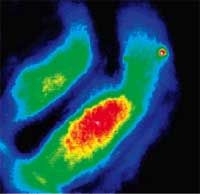 Nanotechnology's poster child, the carbon nanotube (CNT), has been explored for use in many technical applications. Increasingly, researchers are also looking at the unique biological properties of CNTs for potential biomedical uses. For instance, the interaction between DNA and CNTs have been explored and DNA-functionalized nanotubes hold significant promise as nucleic acid sensors. Nanotubes have also been considered for use as scaffolds for cells in tissue engineering. No matter what their intended function, any material used in medicine must exhibit - among other compatibility factors - biocompatibility, non-toxicity and non-carcinogenicity. And here the jury is still out as far as CNTs are concerned. One limiting factor of toxicological studies so far has been the use of animal tissue rather than living specimen. Researchers have now succeeded in detecting single-walled CNTs (SWCNTs) inside living animals - with surprisingly benign results - paving the way for future research on the effects and fate of nanotubes inside living organisms.
Nanotechnology's poster child, the carbon nanotube (CNT), has been explored for use in many technical applications. Increasingly, researchers are also looking at the unique biological properties of CNTs for potential biomedical uses. For instance, the interaction between DNA and CNTs have been explored and DNA-functionalized nanotubes hold significant promise as nucleic acid sensors. Nanotubes have also been considered for use as scaffolds for cells in tissue engineering. No matter what their intended function, any material used in medicine must exhibit - among other compatibility factors - biocompatibility, non-toxicity and non-carcinogenicity. And here the jury is still out as far as CNTs are concerned. One limiting factor of toxicological studies so far has been the use of animal tissue rather than living specimen. Researchers have now succeeded in detecting single-walled CNTs (SWCNTs) inside living animals - with surprisingly benign results - paving the way for future research on the effects and fate of nanotubes inside living organisms.
Nov 7th, 2007
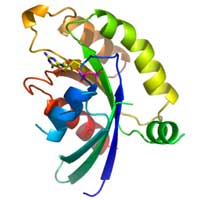 Proteins, large organic compounds made of amino acids, provide many of the most basic units of function in living systems. They make up about half of the dry mass of animals and humans. There may be as many as 1 million different types of proteins in the human body (it is estimated that the human proteome is comprised of an average of 5-7 protein isoforms per open reading frame in the human genome and a further 600 000-odd immunoglobulins present in serum at any given moment) - nobody really knows. The word protein comes from the Greek prota, meaning 'of primary importance', and they actually may become of great importance in nanoscale fabrication as well. Proteins have an amazing number of functions inside our bodies: Enzymes serve as catalysts to break down food into various components; transport proteins such as hemoglobin transport molecules (e.g. oxygen); storage proteins store molecules (e.g. iron is stored in the liver as a complex with the protein ferritin); structural proteins such as keratin or collagen are needed for mechanical support in tissues like cartilage and skin but also hair and nails; proteins are the major component of muscles and for instance actin or myosin are key to contracting muscle fibers; hormones control the growth of cells and their differentiation; antibody proteins are needed for immune protection; and toxins are, well, toxic, but in minute amounts could have beneficial medical properties. Scientists believe that this variety of natural protein functions - actuation, catalysis, structural transport and molecular sequestering - could serve as valuable and versatile building blocks for synthesis of functional materials. Researchers now have found that nanometer-scale changes in protein conformation can be translated into macroscopic changes in material properties. The result is a new class of dynamic, protein-based materials.
Proteins, large organic compounds made of amino acids, provide many of the most basic units of function in living systems. They make up about half of the dry mass of animals and humans. There may be as many as 1 million different types of proteins in the human body (it is estimated that the human proteome is comprised of an average of 5-7 protein isoforms per open reading frame in the human genome and a further 600 000-odd immunoglobulins present in serum at any given moment) - nobody really knows. The word protein comes from the Greek prota, meaning 'of primary importance', and they actually may become of great importance in nanoscale fabrication as well. Proteins have an amazing number of functions inside our bodies: Enzymes serve as catalysts to break down food into various components; transport proteins such as hemoglobin transport molecules (e.g. oxygen); storage proteins store molecules (e.g. iron is stored in the liver as a complex with the protein ferritin); structural proteins such as keratin or collagen are needed for mechanical support in tissues like cartilage and skin but also hair and nails; proteins are the major component of muscles and for instance actin or myosin are key to contracting muscle fibers; hormones control the growth of cells and their differentiation; antibody proteins are needed for immune protection; and toxins are, well, toxic, but in minute amounts could have beneficial medical properties. Scientists believe that this variety of natural protein functions - actuation, catalysis, structural transport and molecular sequestering - could serve as valuable and versatile building blocks for synthesis of functional materials. Researchers now have found that nanometer-scale changes in protein conformation can be translated into macroscopic changes in material properties. The result is a new class of dynamic, protein-based materials.
Nov 6th, 2007
 Animals that cling to walls and walk on ceilings owe this ability to micro- and nanoscale attachment elements. The highest adhesion forces are encountered in geckos. For centuries, the ability of geckos to climb any vertical surface or hang from ceilings with one toe has always generated considerable interest. A gecko is the heaviest animal that can 'stand' on a ceiling, with its feet over its head. This is why scientists are intensely researching the adhesive system of the tiny hairs on its feet. On the sole of a gecko's toes there are some one billion tiny adhesive hairs called setae (3-130 micrometers in length), splitting into even smaller spatulae (about 200 nanometers in both width and length) at the end. It was found that these elastic hairs induce strong van der Waals forces. This finding has prompted many researchers to use synthetic microarrays to mimic gecko feet. Recent work, mainly from A. Dhinojwala, P.M. Ajayan, M. Meyyappan, and L. Dai groups, as well as the Max Planck Institute for Metals Research in Germany (see our previous Spotlight: Gecko nanotechnology), has indicated that aligned carbon nanotubes (CNTs) sticking out of substrate surfaces showed strong nanometer-scale adhesion forces. Although carbon nanotubes are thousands of times thinner than a human hair, they can be stronger than steel, lighter than plastic, more conductive than copper for electricity and diamond for heat. Applications of such bio-inspired development of artificial dry adhesive systems with aligned carbon nanotubes could range from low-tech fridge magnets to holding together electronics or even airplane parts.
Animals that cling to walls and walk on ceilings owe this ability to micro- and nanoscale attachment elements. The highest adhesion forces are encountered in geckos. For centuries, the ability of geckos to climb any vertical surface or hang from ceilings with one toe has always generated considerable interest. A gecko is the heaviest animal that can 'stand' on a ceiling, with its feet over its head. This is why scientists are intensely researching the adhesive system of the tiny hairs on its feet. On the sole of a gecko's toes there are some one billion tiny adhesive hairs called setae (3-130 micrometers in length), splitting into even smaller spatulae (about 200 nanometers in both width and length) at the end. It was found that these elastic hairs induce strong van der Waals forces. This finding has prompted many researchers to use synthetic microarrays to mimic gecko feet. Recent work, mainly from A. Dhinojwala, P.M. Ajayan, M. Meyyappan, and L. Dai groups, as well as the Max Planck Institute for Metals Research in Germany (see our previous Spotlight: Gecko nanotechnology), has indicated that aligned carbon nanotubes (CNTs) sticking out of substrate surfaces showed strong nanometer-scale adhesion forces. Although carbon nanotubes are thousands of times thinner than a human hair, they can be stronger than steel, lighter than plastic, more conductive than copper for electricity and diamond for heat. Applications of such bio-inspired development of artificial dry adhesive systems with aligned carbon nanotubes could range from low-tech fridge magnets to holding together electronics or even airplane parts.
Nov 5th, 2007
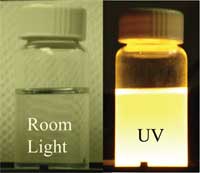 Nanotechnologies opened a new door towards the development of novel techniques and devices for probing biological systems such as biomolecules and single cells. The most reliable bioprobes today rely on fluorescent or radioactive labeling. Phosphorescent emitters are preferable for use in sensing or biological labeling schemes because the emission occurs over a very long timescale (for nanoscientists, 'very long timescale' is a relative term; here we are talking about 1 microsecond). Especially semiconductor nanocrystals (quantum dots) possess several properties that make them very attractive for fluorescent tagging: broad excitation spectrum, narrow emission spectrum, precise tunability of their emission peak, longer fluorescence lifetime than organic fluorophores and negligible photobleaching. Scientists have discovered that these nanocrystals can enable researchers to study cell processes at the level of a single molecule and may significantly improve the diagnosis and treatment of diseases such as cancers. However, the band gap of most emissive semiconductors, with the exception of cadmium-containing materials, is either too high or too low to easily make visible emitting quantum dots. Unfortunately, cadmium is quite toxic and therefore not really suitable for medical applications. In a step towards circumventing the issues with cadmium toxicity, researchers have make progress in demonstrating visible phosphorescence from doped nanocrystal systems. A recent example is the synthesis of a nanoscopic material composed of the non-toxic elements zinc, selenium, sulfur and manganese which displays efficient visible emission.
Nanotechnologies opened a new door towards the development of novel techniques and devices for probing biological systems such as biomolecules and single cells. The most reliable bioprobes today rely on fluorescent or radioactive labeling. Phosphorescent emitters are preferable for use in sensing or biological labeling schemes because the emission occurs over a very long timescale (for nanoscientists, 'very long timescale' is a relative term; here we are talking about 1 microsecond). Especially semiconductor nanocrystals (quantum dots) possess several properties that make them very attractive for fluorescent tagging: broad excitation spectrum, narrow emission spectrum, precise tunability of their emission peak, longer fluorescence lifetime than organic fluorophores and negligible photobleaching. Scientists have discovered that these nanocrystals can enable researchers to study cell processes at the level of a single molecule and may significantly improve the diagnosis and treatment of diseases such as cancers. However, the band gap of most emissive semiconductors, with the exception of cadmium-containing materials, is either too high or too low to easily make visible emitting quantum dots. Unfortunately, cadmium is quite toxic and therefore not really suitable for medical applications. In a step towards circumventing the issues with cadmium toxicity, researchers have make progress in demonstrating visible phosphorescence from doped nanocrystal systems. A recent example is the synthesis of a nanoscopic material composed of the non-toxic elements zinc, selenium, sulfur and manganese which displays efficient visible emission.
Nov 2nd, 2007
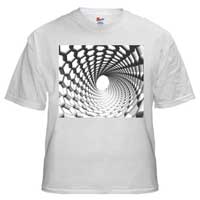 Granted, they don't sell them at Gap yet, but if current research undertaken by scientists in Australia is any indication, bullet-proof vests as light as T-shirts could become reality in the not too-distant future. Carbon nanotubes (CNTs) have great potential applications in making ballistic-resistance materials. The remarkable properties of CNTs makes them an ideal candidate for reinforcing polymers and other materials, and could lead to applications such as ligh-weight bullet-proof vests or shields for military vehicles and spacecraft. For these applications, thinner, lighter, and more flexible materials with superior dynamic mechanical properties are required than what is currently available. Ongoing research at the University of Sydney explores the energy absorption capacity of single-walled carbon nanotubes under a ballistic impact. CNT reinforced materials might not only be very effective in stopping ballistic penetration or high speed impact, like Kevlar vests, but they might also be able to prevent the blunt force trauma that still is a problem with today's body armor.
Granted, they don't sell them at Gap yet, but if current research undertaken by scientists in Australia is any indication, bullet-proof vests as light as T-shirts could become reality in the not too-distant future. Carbon nanotubes (CNTs) have great potential applications in making ballistic-resistance materials. The remarkable properties of CNTs makes them an ideal candidate for reinforcing polymers and other materials, and could lead to applications such as ligh-weight bullet-proof vests or shields for military vehicles and spacecraft. For these applications, thinner, lighter, and more flexible materials with superior dynamic mechanical properties are required than what is currently available. Ongoing research at the University of Sydney explores the energy absorption capacity of single-walled carbon nanotubes under a ballistic impact. CNT reinforced materials might not only be very effective in stopping ballistic penetration or high speed impact, like Kevlar vests, but they might also be able to prevent the blunt force trauma that still is a problem with today's body armor.
Nov 1st, 2007
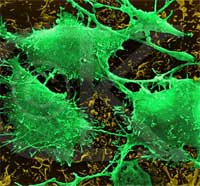 Cancer is an enormous socio-economic problem. According to the National Cancer Institute (NCI), it is estimated that in 2007 there will be over 1.4 million new cases of cancer (of any type) and over 550,000 deaths from cancer in the United States (you can download a detailed Cancer Statistics 2007 Presentation; ppt download, 808 KB) from the American Cancer Society. This makes cancer the second deadliest disease category, after heart diseases. But while the mortality rates for heart diseases have dropped by more than half from 1950 to 2004, and other major disease categories show similar trends, cancer death rates have stayed pretty much the same. Shocking but true, if you are a male living in the U.S., your lifetime probability of developing some type of cancer is 1 in 2. If you are female, your probability is 1 in 3. Equally dismal are the economic cost associated with this disease: The amount of direct cancer-related costs (treatment, care and rehabilitation) have reached $74 billion in the U.S. in 2005, and growing fast, while the overall economic costs (including loss of economic output due to days off and premature death) are estimated to be over $200 billion per year (2005 data). This Spotlight will discuss existing and new approaches to fight cancer and their limitations. The goal is to stimulate readers to support and participate in interdisciplinary research and teaching efforts toward relieving suffering and death due to cancer. Fighting cancer involves three phases: (i) detection, (ii) treatment, and (iii) monitoring. Success depends on matching science to the actual practical needs. We'll take a look at - in particular nanotechnology - efforts underway in the direction of these three phases and comment on some of the practical problems encountered fighting cancer. We also speculate about some unconventional research that might be successful fighting cancer in the future.
Cancer is an enormous socio-economic problem. According to the National Cancer Institute (NCI), it is estimated that in 2007 there will be over 1.4 million new cases of cancer (of any type) and over 550,000 deaths from cancer in the United States (you can download a detailed Cancer Statistics 2007 Presentation; ppt download, 808 KB) from the American Cancer Society. This makes cancer the second deadliest disease category, after heart diseases. But while the mortality rates for heart diseases have dropped by more than half from 1950 to 2004, and other major disease categories show similar trends, cancer death rates have stayed pretty much the same. Shocking but true, if you are a male living in the U.S., your lifetime probability of developing some type of cancer is 1 in 2. If you are female, your probability is 1 in 3. Equally dismal are the economic cost associated with this disease: The amount of direct cancer-related costs (treatment, care and rehabilitation) have reached $74 billion in the U.S. in 2005, and growing fast, while the overall economic costs (including loss of economic output due to days off and premature death) are estimated to be over $200 billion per year (2005 data). This Spotlight will discuss existing and new approaches to fight cancer and their limitations. The goal is to stimulate readers to support and participate in interdisciplinary research and teaching efforts toward relieving suffering and death due to cancer. Fighting cancer involves three phases: (i) detection, (ii) treatment, and (iii) monitoring. Success depends on matching science to the actual practical needs. We'll take a look at - in particular nanotechnology - efforts underway in the direction of these three phases and comment on some of the practical problems encountered fighting cancer. We also speculate about some unconventional research that might be successful fighting cancer in the future.
Oct 31st, 2007
 The controversy over the use of nanoparticles in everyday cosmetics has been going on for a while now. At best, the evidence is inconclusive - it is too early to say whether there is a risk or not. Regulators have no specific research findings to act on. Cosmetic firms of course claim that their products are safe and comply with all the relevant laws and regulations. On the other hand, they fight tooth and nail to have to label their products containing synthetic nanoparticles. The cosmetic industry's stance is even more perplexing given the common sense approach that regulators are taking.
The controversy over the use of nanoparticles in everyday cosmetics has been going on for a while now. At best, the evidence is inconclusive - it is too early to say whether there is a risk or not. Regulators have no specific research findings to act on. Cosmetic firms of course claim that their products are safe and comply with all the relevant laws and regulations. On the other hand, they fight tooth and nail to have to label their products containing synthetic nanoparticles. The cosmetic industry's stance is even more perplexing given the common sense approach that regulators are taking.
Oct 30th, 2007
 We have written plenty of Spotlights so far on carbon nanotubes and nanoelectronics. For instance, carbon nanotube (CNT) transistors have the potential to outperform state-of-the-art silicon devices. Researchers around the world have been working for years on advances at the device level, things like switches and wires and optimizing individual CNT transistors. More recently, scientists have begun to integrate nanotechnology-based materials and devices into larger systems - a crucial step in getting nanotechnology from the lab to the fab. Last year, for instance IBM reported to have built the first complete electronic integrated circuit around a single carbon nanotube (An integrated logic circuit assembled on a single carbon nanotube). Researchers in California have now reported another step towards showing nanoelectronics in systems: They have developed the world's first working radio system that receives radio waves wirelessly and converts them to sound signals through a nano-sized detector made of CNTs. Although this is only the demonstration of a single critical component (the CNT as demodulator) of an entire radio system, it is entirely possible that at some point in the future all components of a working radio could be nanoscale, thus allowing a truly nanoscale wireless communications system (apart from the magnitude of the technological achievement, this is probably great news for surveillance freaks, not so much for privacy advocates).
We have written plenty of Spotlights so far on carbon nanotubes and nanoelectronics. For instance, carbon nanotube (CNT) transistors have the potential to outperform state-of-the-art silicon devices. Researchers around the world have been working for years on advances at the device level, things like switches and wires and optimizing individual CNT transistors. More recently, scientists have begun to integrate nanotechnology-based materials and devices into larger systems - a crucial step in getting nanotechnology from the lab to the fab. Last year, for instance IBM reported to have built the first complete electronic integrated circuit around a single carbon nanotube (An integrated logic circuit assembled on a single carbon nanotube). Researchers in California have now reported another step towards showing nanoelectronics in systems: They have developed the world's first working radio system that receives radio waves wirelessly and converts them to sound signals through a nano-sized detector made of CNTs. Although this is only the demonstration of a single critical component (the CNT as demodulator) of an entire radio system, it is entirely possible that at some point in the future all components of a working radio could be nanoscale, thus allowing a truly nanoscale wireless communications system (apart from the magnitude of the technological achievement, this is probably great news for surveillance freaks, not so much for privacy advocates).
Oct 29th, 2007
 Nanotechnology's poster child, the carbon nanotube (CNT), has been explored for use in many technical applications. Increasingly, researchers are also looking at the unique biological properties of CNTs for potential biomedical uses. For instance, the interaction between DNA and CNTs have been explored and DNA-functionalized nanotubes hold significant promise as nucleic acid sensors. Nanotubes have also been considered for use as scaffolds for cells in tissue engineering. No matter what their intended function, any material used in medicine must exhibit - among other compatibility factors - biocompatibility, non-toxicity and non-carcinogenicity. And here the jury is still out as far as CNTs are concerned. One limiting factor of toxicological studies so far has been the use of animal tissue rather than living specimen. Researchers have now succeeded in detecting single-walled CNTs (SWCNTs) inside living animals - with surprisingly benign results - paving the way for future research on the effects and fate of nanotubes inside living organisms.
Nanotechnology's poster child, the carbon nanotube (CNT), has been explored for use in many technical applications. Increasingly, researchers are also looking at the unique biological properties of CNTs for potential biomedical uses. For instance, the interaction between DNA and CNTs have been explored and DNA-functionalized nanotubes hold significant promise as nucleic acid sensors. Nanotubes have also been considered for use as scaffolds for cells in tissue engineering. No matter what their intended function, any material used in medicine must exhibit - among other compatibility factors - biocompatibility, non-toxicity and non-carcinogenicity. And here the jury is still out as far as CNTs are concerned. One limiting factor of toxicological studies so far has been the use of animal tissue rather than living specimen. Researchers have now succeeded in detecting single-walled CNTs (SWCNTs) inside living animals - with surprisingly benign results - paving the way for future research on the effects and fate of nanotubes inside living organisms.
 Subscribe to our Nanotechnology Spotlight feed
Subscribe to our Nanotechnology Spotlight feed





